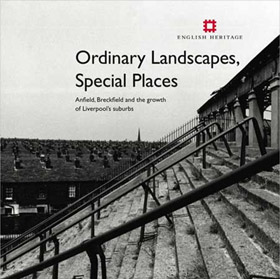
| HOME |
| NERVE |
| REVIEWS |
| ARCHIVE |
| EVENTS |
| LINKS |
| ABOUT US |
| CONTRIBUTORS |
| BACK ISSUES |
| CONTACT US |
 Ordinary
Landscapes, Special Places
Ordinary
Landscapes, Special Places
English Heritage
94pp paperback, £7.99
Reviewed by Jeremy Hawthorn
THIS IS ANFIELD
At last the Capital of Culture year produces a study that isn’t about Liverpool city centre. This book traces the development of the Breckfield and Anfield suburbs. It’s pricey and the title is uninspired, but there are good maps and some excellent photographs.
The area started out as farmland. At the end of the 18th century the upper class moved ‘up the hill’ out of town. Those who missed out on the view from Everton Brow built the first villas in Anfield Road and the ‘Arcadia of Liverpool’ on Breck Road. As the city grew, so the middle class moved in and houses became progressively smaller: lesser villas in St Domingo Grove (1850s), three-storey terraces in St Domingo Vale (1860s) and small brick terraces (1870 to 1900).
Unlike the later districts such as Norris Green and Speke, all the development took place piecemeal in small units, as the owners of the small fields built on them. There was no grand plan. That’s why there are so many triangular buildings at street corners. And none of these phases of housing has been demolished, so you can still see and compare the (now multi-occupied) three-storeys with the two-up-two-downs.
With the growing population of course came parades of shops, churches, schools and pubs. Trams took people to work and back as there were no big local employers. Stanley Park was developed as a recreation space. Then in the late 19th century came…
Well, Liverpool Football Club paid towards this book, so it’s no surprise that they get a separate chapter. You get a potted history of the early days but the main theme is the development of the club site from field to stadium. Disappointingly there’s nothing on the interaction between club and community: what must it have been like to see a mighty new stand named Spion Kop (after a traumatic Boer War battle)?
This study is well-timed as major changes are afoot. The football club are committed to expansion and there is a big picture of the new stadium design (although the American owners have just said they can’t build it). The city council are also committed to large-scale house demolition. Both club and council have been slow to realise quite how much heritage they are about to knock down. The book contains some sharp comments on the need to ‘ensure that valuable evidence of past ways of life is not needlessly destroyed’.
A final chapter shows how you can do your own local research, where you find maps, council records and so on. This book is the last in the Heritage series on Liverpool, but it shows how you could write the next one. Tuebrook, anyone?